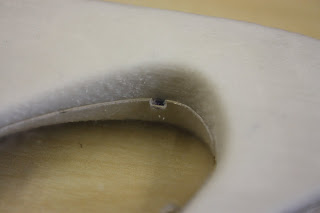


 Kyle Miller and Kory Randa worked collaboratively to create four iterations of joints using a 3d printer. Our main goal throughout this exercise was to experiment with the tolerances of the 3d printer and the gluing process. We experimented with 1/20" as the tolerance. Errors were still encountered through the gluing process which were caused by the printing grain that increased the expansion along the grain when the glue was applied (see last photograph). The glue was dripped over the surface to create an even coat and then placed on plastic spacers to dry. Our first joint was coated with glue that had expired, which created a thicker coat, and infiltrated the powder less, causing a brittle joint. This joint was unfortunately destroyed when our instructor attempted to interact with it (it's ok Tim, we fixed it). When the glue is drying, it tends to run towards the edge of the surface and cause a build up that exceedes the tolerances we had set. We remedied with a belt sander and file.
Kyle Miller and Kory Randa worked collaboratively to create four iterations of joints using a 3d printer. Our main goal throughout this exercise was to experiment with the tolerances of the 3d printer and the gluing process. We experimented with 1/20" as the tolerance. Errors were still encountered through the gluing process which were caused by the printing grain that increased the expansion along the grain when the glue was applied (see last photograph). The glue was dripped over the surface to create an even coat and then placed on plastic spacers to dry. Our first joint was coated with glue that had expired, which created a thicker coat, and infiltrated the powder less, causing a brittle joint. This joint was unfortunately destroyed when our instructor attempted to interact with it (it's ok Tim, we fixed it). When the glue is drying, it tends to run towards the edge of the surface and cause a build up that exceedes the tolerances we had set. We remedied with a belt sander and file.



.JPG)
.JPG)
.JPG)










.jpg)


 o make my assembly easier, the layers were each labeled from A - F. This not only helped with identifying the pieces, but was critical to putting the final model together. Chipboad was an ideal material for this project. It allowed for tolerances and could adjust in certain circumstances. The pieces are obviously still very precise, and have to be for a successful fit. But, the chipboard has a little give making it less likely for failure.
o make my assembly easier, the layers were each labeled from A - F. This not only helped with identifying the pieces, but was critical to putting the final model together. Chipboad was an ideal material for this project. It allowed for tolerances and could adjust in certain circumstances. The pieces are obviously still very precise, and have to be for a successful fit. But, the chipboard has a little give making it less likely for failure. 


























